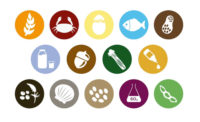On November 30, 2016, the National Academies of Sciences, Engineering and Medicine issued a report with wide-ranging recommendations aimed at providing a road map to improve the situation for individuals with food allergies. Entitled Finding a Path to Safety in Food Allergy: Assessment of the Global Burden, Causes, Prevention, Management, and Public Policy, the report includes recommendations on food allergy diagnostics, prevention, education of various stakeholders, emergency and daily management by caregivers and providers, allergen labeling and development of policy guidelines for a variety of settings to improve safety. The National Academies study was supported by three federal agencies and eight nonfederal sponsors, including two consumer groups and several associations sponsored by growers and/or processors. The study was conducted over an 18-month period by a committee of 15 international experts representing a range of expertise and experience on the topic. This article will focus on the recommendations contained within the report that are aimed at the food industry and/or federal agencies that regulate the food industry. The scope of the report was global, but this article will focus on the impact of the recommendations on the North American (U.S. and Canada) food industry and the agencies that regulate that industry.
Recommendations on Mandatory Allergen Labeling
Several of the report’s recommendations are directly aimed at the enactment of policies that will impact the food industry but, in the opinion of the committee, also improve the quality of life of consumers with food allergies. The labels on packaged foods are a primary conduit of critical information to consumers with food allergies and their caregivers. The primary advice given by healthcare providers to individuals with a food allergy is to avoid ingestion of their offending food(s) to prevent reactions. The ingredient declaration and the “Contains statement” (where used) provide critical information to food-allergic consumers.
Globally, various countries have established different lists of priority allergenic foods and associated labeling regulations that require the declaration of ingredients derived from these foods when they are intentionally used in product formulations (www.farrp.unl.edu/IRChart). Most countries rely on a list of priority allergenic foods established by the Codex Alimentarius Commission in 1999 as guidance to member countries of the World Health Organization and Food & Agriculture Organization (FAO) of the United Nations. That list of eight foods or food groups (milk, eggs, fish, crustacean shellfish, peanuts, tree nuts, soybeans and cereal sources of gluten) was established based upon recommendations from an FAO expert consultation held in 1995. One of the key recommendations in the report focuses on this global guidance:
The Codex Alimentarius Commission and public health authorities in individual countries should decide on a periodic basis about which allergenic foods should be included in their priority lists based on scientific and clinical evidence of regional prevalence and severity of food allergies as well as allergen potency.
The committee recognized that the existing Codex list was reasonable and that regional differences in allergen prevalence exist but recommended that regional additions to the Codex list should be based upon sound scientific and clinical evidence. Clearly, as more scientific and clinical information becomes available over time, a reassessment of these lists should be considered.
The Food Allergen Labeling and Consumer Protection Act of 2004 (FALCPA) in the U.S. and the Safe Foods for Canadians Act (SFCA) in Canada provide excellent labeling regulations to protect consumers with food allergies. FALCPA follows the Codex list with the exception that wheat is specifically recognized as a priority allergenic food because FALCPA focuses on food allergies rather than celiac disease associated with cereal sources of gluten. SFCA includes several additions to the Codex list, namely molluscan shellfish, sesame seeds and mustard. Evidence of the prevalence and severity of allergic reactions to sesame seeds may warrant their inclusion on the priority allergen list in the United States.
The committee’s task was not to make recommendations on specific foods that should be added to the priority allergen list; however, the committee concluded that although solid evidence on the prevalence of specific food allergies in the U.S. does not exist, the U.S. Food and Drug Administration (FDA) should consider the addition of sesame seeds to the U.S. priority allergen list.
After the passage of FALCPA, FDA posted a list of 19 tree nuts on its website associated with FALCPA compliance. In the committee’s opinion, clinical and scientific evidence is lacking to support the inclusion of beechnuts, butternuts, chestnuts, chinquapins, coconuts, ginkgo nuts, hickory nuts, litchi nuts, pili nuts and shea nuts as priority allergenic tree nuts. In fact, litchi is a fruit and coconut is a palm drupe.
Globally, most countries follow the Codex guidance and require the labeling of the priority allergenic foods and any ingredients derived from them. However, the committee recognized that the allergenicity of ingredients from any allergenic source is based upon the protein (allergen) content of that ingredient. The European Union and Australia/New Zealand have provided exemptions from source labeling for certain ingredients where evidence exists that these ingredients are not hazardous to consumers with allergies to the allergenic source of the ingredients. In the U.S., Congress recognized that highly refined oils represent no risk and exempted such oils from the labeling provisions of FALCPA. In addition, FALCPA provided a mechanism for source-labeling exemptions, but FDA has granted only two exemptions (for certain confined uses of Solae soy lecithin and for ice-structuring protein derived from a fish gene). FDA should make its decisions about labeling exemptions for ingredients derived from priority allergenic sources based on a quantitative risk assessment (QRA) framework.
The report contains a comprehensive explanation of the QRA approach that, in the case of ingredients, involves an evaluation of the protein (allergen) content of the ingredient against the known range of individual threshold doses for individuals with allergies to the source of the ingredient.
Related to strengthening policies, the committee made a recommendation to FDA to continue working with other relevant federal, state and local agencies to develop and implement labeling policies specific to allergenic ingredients in packaged and prepared foods that are distributed through airlines and other public venues, including schools and early care and educational facilities. Attention is needed in such venues where packaged food does not enter into interstate commerce and might not be subject to federal labeling laws.
Recommendation on Precautionary Allergen Labeling (PAL)
Unintentional allergens that might occur at low levels, but could still cause a reaction in some individuals, can be identified on the labels of packaged foods with PAL. Currently, PAL usage is voluntary but allowed in most countries. PAL takes dozens of specific formats, including “may contain x,” “manufactured on shared equipment with x” and “packaged in a shared facility with x.” PAL is not risk-based, and evidence from analytical surveys indicates that many products bearing PAL statements contain no detectable allergen residues. Consumer surveys indicate that consumers with food allergies attempt to assign variable levels of risk to products with PAL based upon the wording of the PAL statement. These surveys also reveal that some consumers with food allergies ignore PAL. Consensus expert opinions, including the opinion of the committee, indicate that PAL is confusing to consumers and has lost much of its intended effectiveness. Accordingly, the committee reached the following recommendation:
The food manufacturing industry, FDA, and the U.S. Department of Agriculture (USDA) should work cooperatively to replace the PAL system for low-level allergen contaminants with a new risk-based labeling approach, such as the VITAL (Voluntary Incidental Trace Allergen Labelling) program used in Australia and New Zealand.
To implement this risk-based approach, the committee recommended three further actions:
1. FDA and USDA should establish reference doses (thresholds) for allergenic foods, where possible. The committee concludes that at this time, sufficient data exist on milk, eggs, peanuts, certain tree nuts (cashew, walnut, hazelnut), wheat, soybeans, fish and crustacean shellfish (shrimp) to establish reference doses. FDA and USDA should review the reference doses periodically, with particular attention to the remaining tree nuts for which data to establish reference doses are not currently available (i.e., almond, Brazil nut, macadamia nut and pine nut).
2. Once reference doses are established, a food product would carry an advisory label (e.g., “peanut may be present”) only in situations when ingesting the product would expose the individual to a level above the reference doses for that allergen. FDA should restrict the number of allowable advisory labels to one phrase. Because this labeling is voluntary, the product should clearly inform the consumer, through labeling as appropriate, as to whether a risk-based approach (such as VITAL) has been followed for each specific product. FDA and USDA should educate healthcare providers and consumers about the meaning of such a food allergy advisory statement.
3. FDA and USDA, together with the food industry and the analytical testing industry, should develop and validate detection methods and sampling plans for the various food allergens for which reference doses are established. A common unit of reporting also should be established, such as parts per million of protein from the allergenic source, so that comparisons can be made between methods and between levels in the food and clinical threshold values.
This particular recommendation is complex but, in the view of the committee, critically important to improving the quality of life for food-allergic consumers. Currently, many food products bear PAL statements. If food-allergic consumers avoid all foods with PAL statements, their food choices are seriously restricted. In the committee’s view, PAL guidance from FDA and USDA, working with industry, would lead to more meaningful implementation of PAL where use of a PAL statement would convey the existence of a known level of risk. The committee recognized that considerable clinical data now exist on individual threshold doses for food-allergic consumers that could be used to estimate population thresholds or reference doses. The development of sufficiently robust analytical methods to support the risk-based approach to PAL will require more harmonization and guidance.
State, Local and Tribal Policies for Food Establishments
An individual with a food allergy encounters many settings that offer food. Consumers with food allergies must depend upon personnel in restaurants, retail outlets and retail foodservice establishments (e.g., ice cream parlors, bakeries, grocery stores, food carts) to obtain allergen-safe foods. The FDA Food Code is neither federal law nor federal regulation, but it is a key food policy that provides advice from FDA for uniform systems and practices that address the safety of food sold in operations such as restaurants, retail food stores, food vendors and foodservice operations in institutions, such as schools, hospitals, assisted living, nursing homes and child care centers. The code, which is updated and released every 4 years, is being developed by the Conference of Food Protection, a nonprofit organization created to provide a formal process to develop food safety guidance. Members of industry, academia, regulatory and consumer and professional organizations contribute to the development of the Food Code. The 2013 FDA Food Code includes provisions on preventing food-allergic reactions. As of October 2015, all 50 states and the District of Columbia had adopted codes patterned after previous versions of the FDA Food Code, but not all have adopted the 2013 Food Code.
All state, local and tribal governmental agencies should adopt the 2013 FDA Food Code, which includes provisions for food establishments on preventing food-allergic reactions. Working in collaboration with other stakeholders, the agencies should also propose that the next Food Code release require that the person in charge in food establishments pass an accredited food safety certification program that includes basic food allergy management to decrease or prevent the risk of food allergen exposure. In addition, agencies should develop guidance on effective approaches to inform consumers with food allergies in foodservice establishments.
The committee considered that guidance on effective approaches to inform consumers with food allergens could include menu designations of allergens, posters and other forms of displaying information about food allergens in food establishments.
Recommendation on Training
The committee recognized that food allergens are an important public health issue that impacts the food continuum from farm to fork. Thus, awareness of and training on food allergens is essential. The committee made the following recommendation:
Food industry leaders should provide the necessary resources for integrating food allergy training (e.g., food allergen identification and preventive controls, effective risk communication with customers) into existing general food safety and customer service training for employees at all levels and stages in the food industry, as appropriate, encompassing processing, retail food and grocery stores, restaurants and other foodservice venues.
As noted, this training recommendation impacts all sectors of the food industry from processing to various retail food outlets. The committee recognized that training does exist currently but that the use and the effectiveness of training across all sectors of the food continuum are variable and could be improved.
Other Recommendations
The report contains numerous other recommendations. While these other recommendations do not primarily impact the packaged food or foodservice industries, the implementation of these recommendations will have some effect on food industry stakeholders. One of the key recommendations in the report calls for assessment of the true prevalence of food allergies in the U.S. Currently, prevalence estimates are based upon clinical surveys of allergic individuals that rely upon self-reporting. A rigorous, clinically sound assessment of the prevalence of food allergies would help underscore the importance of this public health issue.
Another key area of emphasis within the report relates to preventing food allergies from developing. Clearly, the development of food allergies is a complex process, with many likely contributing variables. Disturbingly, the prevalence of food allergies appears to be increasing, and the factors behind the increase are not yet fully understood. However, as research points toward effective measures, the food industry will probably find opportunities to contribute to the implementation of these measures. As an example, the early introduction of peanuts into the diets of weaning infants has been shown to reduce the prevalence of peanut allergy development. The research leading to the discovery of this approach was initiated by the observation of a very low prevalence of peanut allergy in Israel, where a peanut-containing snack food (Bamba) was popularly used as a weaning food.
Thus, we encourage interested parties to read the entire report and consider all the recommendations. In summary, this landmark report provides numerous avenues for the food industry and regulatory/public health agencies to bring the recommendations to bear to improve health and safety for food-allergic consumers.
Disclaimer: The authors’ views do not necessarily represent the views of the National Academies of Sciences, Engineering and Medicine, their committees or convening bodies.
Steve L. Taylor, Ph.D., is a professor in the Department of Food Science & Technology and cofounder and codirector of the Food Allergy Research and Resource Program at the University of Nebraska–Lincoln. He served as a member of the committee that generated the report.
Maria Oria, Ph.D., is senior program officer at the National Academies of Science, Engineering and Medicine. She served as the director of the study.
Report from the National Academies of Sciences, Engineering and Medicine: Recommendations to the Food Industry and Regulatory Agencies on the Management of Food Allergens




